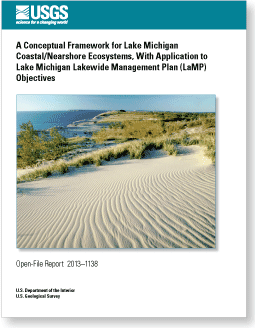 Abstract Abstract
The Lakewide Management Plans (LaMPs) within the Great Lakes region are examples of broad-scale, collaborative resource-management efforts that require a sound ecosystems approach. Yet, the LaMP process is lacking a holistic framework that allows these individual actions to be planned and understood within the broader context of the Great Lakes ecosystem. In this paper we (1) introduce a conceptual framework that unifies ideas and language among Great Lakes managers and scientists, whose focus areas range from tributary watersheds to open-lake waters, and (2) illustrate how the framework can be used to outline the geomorphic, hydrologic biological, and societal processes that underlie several goals of the Lake Michigan LaMP, thus providing a holistic and fairly comprehensive roadmap for tackling these challenges. For each selected goal, we developed a matrix that identifies the key ecosystem processes within the cell for each lake zone and each discipline; we then provide one example where a process is poorly understood and a second where a process is understood, but its impact or importance is unclear. Implicit in these objectives was our intention to highlight the importance of the Great Lakes coastal/nearshore zone. Although the coastal/nearshore zone is the important linkage zone between the watershed and open-lake zones—and is the zone where most LaMP issues are focused—scientists and managers have a relatively poor understanding of how the coastal/nearshore zone functions. We envision follow-up steps including (1) collaborative development of a more detailed and more complete conceptual model of how (and where) identified processes are thought to function, and (2) a subsequent gap analysis of science and monitoring priorities.
|
First posted August 2, 2013
Part or all of this report is presented in Portable Document Format (PDF); the latest version of Adobe Reader or similar software is required to view it. Download the latest version of Adobe Reader, free of charge. |